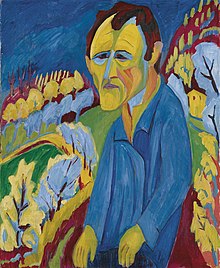Hermann Scherer (painter)
Hermann Scherer (born February 8, 1893 in Rümmingen ( Markgräflerland ), † May 13, 1927 Basel ) was a German-Swiss painter of Expressionism .
Life
After finishing school in Lörrach in 1907, Hermann Scherer began an apprenticeship as a stonemason in the Schwab workshop in Lörrach. From 1910 to 1919 he worked as a stonemason successively for the Basel sculptors Carl Gutknecht , Otto Roos and Carl Burckhardt . Around 1919/1920 Hermann Scherer turned to a contemporary conception of art (and painting). In this context, he destroyed many of the works he had created up to that point.
A visit to an Edvard Munch exhibition at the Kunsthaus Zurich and his acquaintance with Ernst Ludwig Kirchner had a decisive influence on his further artistic development in the early 1920s . From 1922 to 1924 he spent several longer periods of work in Frauenkirch near Davos . In 1924 he took part in the exhibition of recent German art in Stuttgart with three of his wooden sculptures. At the end of 1924, together with Albert Müller and Paul Camenisch, he founded the artist group “ Rot-Blau ”, an artists' association based on the model of the “ Brücke ”, which Werner Neuhaus later joined and which made the most important contribution to Swiss Expressionism.
This group of artists received great public feedback for the first time at an exhibition by the Basler Kunstverein and later in Zurich in 1925. Individual works were rejected as offensive in both Basel and Zurich.
Although Kirchner and Scherer fell out in 1925, artistic contacts were maintained. In this way Kirchner brokered the participation of the Red-Blue group in the International Art Exhibition in Dresden in 1926.
Hermann Scherer fell ill in autumn 1926 and died on May 13, 1927. The following year the Kunsthalle Basel commemorated the artist with an exhibition that presented more than 200 of his works. The Dreiländermuseum in Lörrach houses 118 objects by Scherer in its collection, including woodcuts and the portrait of Otto Staiger .
Others
In Rümmingen, a street and a fountain were named after him in memory of Scherer. In 2004 the Pfalzgalerie Kaiserslautern acquired the sculpture “The Little Girl” from a Swiss art gallery for over 284,500 euros.
Solo exhibitions
- 1926: Zurich, exhibition Rot Blau Kunsthaus
- 1927: Dresden, international art exhibition
- 1994: Davos, Hermann Scherer , Iris Wazzau Gallery
- 1995: Wichtrach / Bern Hermann Scherer Gallery Henze & Ketterer
- 2007–2008: Bern, Art Museum ; Groningen, Groninger Museum; Chur, Bündner Art Museum Expressionism from the Mountains - Kirchner, Bauknecht, Wiegers and the group Rot Blau
- 2012–2013: Davos, Galerie Iris Wazzau, Ernst Ludwig Kirchner and Hermann Scherer. A comparison
- 2019–2020: Freiburg, Museum of New Art , Expressionist Scherer - more direct, raw, emotional
literature
- Beat Stutzer (Ed.): Hermann Scherer - sculptures, paintings, woodcuts. Bündner Kunstmuseum Chur. Scheidegger & Spiess, Zurich 1999.
- Horst Donner: On the way to becoming a great artist. The painter and sculptor Hermann Scherer was born in Rümmingen 125 years ago. In: Das Markgräflerland, Volume 2018, pp. 131–142.
- Franz Gerhard: The sculptor and painter Hans Scherer. In: Architektur und Kunst, Volume 52 1952. E-Periodica
Web links
- Literature by and about Hermann Scherer in the catalog of the German National Library
- Tapan Bhattacharya: Scherer, Hermann. In: Historical Lexicon of Switzerland .
- Martin Schwander: Scherer, August Hermann. In: Sikart
- Hermann Scherer In: Art Credit Collection
- The time for an exhibition in Stuttgart in 1988
- Hermann Scherer, group exhibition, Dunkel – Hell, a chapter of Basler Kunst In: Galerie Müller, Basel, 2019
- Dominique Spirgi: Exhibition Dunkel - Hell In: Basler Zeitung , September 26, 2019
Individual evidence
- ↑ "Portrait of Otto Staiger" . Dreiländermuseum website, collection database. Retrieved April 15, 2015.
- ^ [1] Purchase of the Pfalzgalerie Kaiserslautern, website Kunstportal Pfalz from September 7, 2004
- ↑ Municipal museums: Expressionist Scherer - more direct, raw, emotional - www.freiburg.de/museen. Retrieved September 30, 2019 .
| personal data | |
|---|---|
| SURNAME | Scherer, Hermann |
| BRIEF DESCRIPTION | German-Swiss painter and sculptor |
| DATE OF BIRTH | February 8, 1893 |
| PLACE OF BIRTH | Rümmingen |
| DATE OF DEATH | May 13, 1927 |
| Place of death | Basel |

